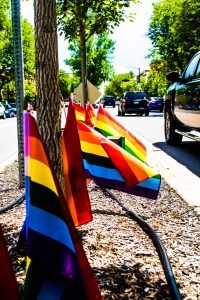This content was originally published by the Longmont Observer and is licensed under a Creative Commons license.
Boulder County is home to a large LGBT+ population and has long been held up as a bastion of progressiveness and acceptance. But within the community, and the people who support it, this experience doesn’t ring true. In 2018, Out Boulder pursued and received grant funding in order to survey the LGBT+ community in Boulder County, in hopes that analytics could corroborate anecdotal evidence.
Mardi Moore, executive director of Out Boulder, was glad to have the results. “Having these numbers, all of a sudden it’s not just Mardi telling a story. We captured good data, which lends credibility to what we already know.”
The survey itself was put together by Out Boulder staff in collaboration with Spencer Dudley at CU Boulder. Participants were pulled from the community at large through social media and direct access at Pride events in Longmont and Boulder. After a year of analysis, the results have been released to the public.
“There were no surprises,” said Moore. “What it did was make me feel like I wasn’t crazy. What we were experiencing is what we found in the results, which is that the mental health of the community is in dire straits.”
Given the current climate in the country as a whole, the data is far from surprising. Mental health within the LGBT+ community proved to be in a poor state. Nearly a third of the participants lacked in human connection, and a quarter of the participants reported feeling sad or hopeless during the same period. At least 13% of participants acknowledge making a suicide plan within the month prior to taking the survey, and 4% had made suicide attempts.
Moreover, incidents of bias, assault and discrimination in Boulder County match those at a national level. At least 11% of participants responded yes to experiencing a hate crime based on gender identity, while 19% responded yes to experiencing a hate crime based on sexual orientation. Incidents of verbal assault based on gender identity and sexual orientation were much higher, at 29% and 45% respectively. Less than 20% of those that had experienced incidents of verbal assault reported the crimes to law enforcement.
The disparity of these statistics get even more bleak when the analysis focuses on just the transgender community, a stunning 71% of participants in the transgender community experience verbal assault based on gender identity.
The most commonly given responses for not filing reports were fear that they would not be taken seriously or that there would be no recourse. There were also those that felt the process of reporting would be as traumatic, or more so, than the experience itself.
Though the data can be hard to take in, the results have provided a good idea of where Out Boulder and its partners can focus their attention. Ongoing partnerships with organizations like Boulder Community Health can now focus on treating both the LGBT people that need it and the counselors and organizers that experience secondary trauma. There are also avenues of support being better developed through programs like Applied Suicide Intervention Skills Training (ASIST).

There continues to be positive methods of outreach in Boulder County, within the organization and out. Out Boulder is sponsoring a workshop on Civil Discourse in a Volatile Time, Saturday, September 21st, as a way to provide the community with tools to address bias and harassment productively. In addition, they are hoping for more funding at the state level to help continue their work with local law enforcement in promoting better awareness and communication.
There is still work to be done for the LGBT+ community, and for Boulder County as a whole, but having the survey results presents avenues for targeted support. The survey results are available at Out Boulder’s website, as well as volunteer opportunities.

.jpg;w=120;h=80;mode=crop)
